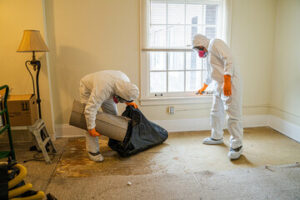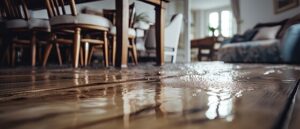Having an emergency plan and knowing what to do in the event of a disaster is important. Water Damage Restoration Utah can help with the process by inspecting and assessing the damage, cleaning and drying contents, and performing repairs.
Water and moisture are a dangerous combination, and wet materials start developing mold in as little as 24 hours. It is essential to take immediate action to avoid further damage and loss of property.

Identify The Source Of The Water
Water damage is one of the most destructive forces to a home or business. It can cause structural damage and create an environment that is a breeding ground for mold, bacteria, and fungi. Whether the damage is caused by a burst pipe, a flood, or a slow leak, some steps can be taken to repair and restore the property.
The first step is to identify the source of the water damage. This can be done by looking at the water staining on the walls and ceilings, examining the building materials for signs of moisture, and following the path of the water to find the source. If the water is coming from a faulty pipe, an examination of the plumbing fixtures can often find the source.
A professional can also help with this process by determining the level of the water damage and what parts of the building have been affected. This helps them to determine the best plan of action for drying out the structure and getting it back to normal.
Once the source of the water has been identified, it is important to stop the flow of water as quickly as possible. This can be done by shutting off any water or electrical sources in the area. If there is any electricity running to the damaged areas, it will be important to have a professional remove the power meter to ensure that all of the electricity is turned off.
The next step is to remove any items that cannot be saved from the water damage. This can be anything from personal belongings like clothing and shoes to furniture and electronics. It is also important to remove any standing water from the area using a wet/dry shop vacuum. This will help to speed up the drying process and reduce the risk of additional damage.
Remove Water
It’s essential to remove the water as quickly as possible. Fortunately, professional restoration companies have the equipment necessary to do this quickly and efficiently. This includes large pumps that can clear out gallons of water in one go. They also use wet/dry shop vacs to clear out any remaining water in rooms or on furniture and other items.
Before beginning to pump out the water, a team of professionals will conduct a thorough assessment of the damage. They’ll check every room in your home from the basement to the attic to determine the extent of the damage. This will help them find the source of the problem and decide on an appropriate strategy.
Once they’ve surveyed the area, they’ll begin to remove any materials that aren’t salvageable. This might include drywall, flooring, and insulation. In some cases, it may also be necessary to remove and replace wood components like baseboards and rotting wood. This is done to prevent further structural damage to your home.
Then, they’ll dry out the affected area. They’ll use fans and dehumidifiers to create a flow of air in the room and speed up the drying process. It’s important to dry out the area as quickly as possible because standing water can breed mold and bacteria in just 48 hours.
If you’re working with a home insurance company to recover from the loss, it’s a good idea to start documenting your losses immediately. This will help you get the compensation you deserve. Be sure to photograph any damaged items and take detailed notes. This will ensure that your claim is processed smoothly and that you don’t miss out on any money you deserve.
Disinfect The Area
Water damage can cause your personal belongings, such as furniture, to be ruined and can also lead to serious structural damage to your property. This is why it is so important to act quickly when water damage occurs to prevent further damage and ensure your safety.
In addition to causing damage to your property, untreated water damage can lead to health issues. This is because bacteria, molds, fungi, and other contaminants that are often found in flood waters can cause health problems in humans and animals. Some of these problems include skin irritation, nausea, fatigue, coughing, shortness of breath, and wheezing.
One of the first things that you should do when you notice water damage is to remove any standing water. You should use buckets, mops, or a wet/dry vacuum to remove the water as soon as possible. If the area is safe to enter, you should also turn off any electricity that may be in the affected area.
Once the water has been removed, you should disinfect the area. This is because untreated water damage can cause mildew and mold growth, which can contaminate your home and cause health problems for you and your family.
To disinfect the area, you should use a deodorizing product and sanitizer. You should also wipe down all surfaces that were affected by the water. You should also remove any porous items, such as carpet cushions and pads, from the area. Once the area has been disinfected, you should then dry it out as much as possible. You can do this by opening the windows and using a fan to circulate the air. This will help to speed up the drying process and prevent the formation of mold and mildew.
Dry Out The Area
Water damage is one of the most common problems that homeowners face. It can ruin cherished possessions, lead to expensive repairs, and potentially cause health risks like mold development. Fortunately, there are some things you can do to mitigate the damage and save your home or business.
After shutting off the electricity and identifying the source of the water, it is time to start the cleanup process. If possible, remove all items from the affected area and sort them into salvageable and unsalvageable piles. Carpeting, wallpaper, paper products, food, and most electronics are likely to be a loss, while rugs and furniture may be able to be saved with prompt action from remediation experts.
Once you have removed any standing water and checked for external signs of mold, it is important to open up the area as much as possible and get airflow moving. This will help to dry out the surrounding materials and reduce the risk of mold and mildew developing.
Ideally, you should use fans and dehumidifiers to create as much airflow as possible in the area. This will help to move moisture away from the affected area and prevent it from damaging wood, drywall, and other materials.
It is also a good idea to use deodorizers in the area, as mold spores can be very odoriferous. Foggers are a particularly effective way of deodorizing as they convert deodorizing liquids into a fine mist or fog that can penetrate deep into porous surfaces, removing stubborn odors.
Restore Your Property
It’s critical to contact a water damage restoration expert right away, even if your insurance doesn’t cover the entire cost of repairs. They can walk you through the process of assessing the damage and creating a restoration strategy. They can also provide you with referrals to local contractors who specialize in restoring properties after water damage.
Once a professional has assessed the damage, they’ll need to find the source of the water. This will help them determine the severity of the damage as well as how long the water has been there. This is important because the longer that standing water remains, the more damage it can cause. For example, mildew and mold growth can lead to serious health issues, and structural problems can occur as a result of prolonged water damage.
After identifying the source of the water, professionals will start to remove it from the property. This may include removing insulation, carpeting, and other materials that have been impacted by the water damage. They’ll also take steps to sanitize the area by using HEPA vacuuming and anti-microbial spray. In cases of severe water damage, they may need to use a dehumidifier to remove excess moisture.
Before you buy a home that has been damaged by water, get an inspection from a trusted real estate agent and get estimates from restoration companies. This way, you can determine if the home is worth the price or if you’ll need to negotiate a lower price. If the water damage is extensive, you should consider avoiding purchasing the home altogether.
